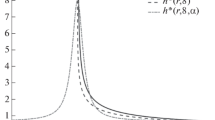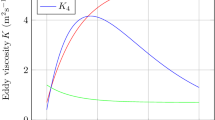Abstract
The influence of the Ekman friction on the dynamics of zonal flows (ZFs) has been studied within the framework of a quasigeostrophic model of the atmosphere with two horizontal boundaries (the underlying surface and the tropopause). It is assumed that these flows have zero potential vorticity and are caused by specified buoyancy distributions at the boundaries. It is shown that, in the case of periodic distributions, the oppositely directed vertical velocity profile of ZFs transforms into a unidirectional profile with a maximum velocity at the upper boundary and zero velocity at the lower boundary. During this transformation, the velocity at the upper boundary increases; i.e., the upper tropospheric ZFs intensify due to the Ekman friction. A similar intensification occurs also in the case of initial distributions of buoyancy of the frontal type, which induce a system of two oppositely directed jet flows located in the upper and lower halves of the atmospheric layer. Due to the Ekman friction, the axial velocity of the lower flow drops to zero and the velocity of the upper flow, gradually covering the entire troposphere, doubles. The resulting flow is a jet pressed against the upper boundary, which may be considered a prototype of a western upper tropospheric jet flow. The important structural features of such a jet, which are established within the framework of a complete nongeostrophic model, are associated with horizontal jet asymmetry and the formation of fronts (discontinuity surfaces) adjacent to the upper boundary.





Similar content being viewed by others
REFERENCES
A. Gill, Atmosphere–Ocean Dynamics, Vol. 2 (Academic Press, New York, 1982; Mir, Moscow, 1986).
J. Pedlosky, Geophysical Fluid Dynamics (Springer, Berlin, 1987).
G. K. Vallis, Atmospheric and Oceanic Fluid Dynamics. Fundamentals and Large-Scale Circulation (Cambridge Univ. Press, Cambridge, 2006).
F. V. Dolzhansky, Fundamentals of Geophysical Hydrodynamics (Springer, Berlin, 2013).
H. P. Greenspan, The Theory of Rotating Fluids (Cambridge Univ. Press, New York, 1968; Gidrometeoizdat, Leningrad, 1975).
F. V. Dolzhanskii, V. A. Krymov, and D. Yu. Manin, “Stability and vortex structures of quasi-two-dimensional shear flows,” Phys.-Usp. 33 (7), 495–520 (1990).
G. P. Willams and J. Robinson, “Generalized Eady waves with Ekman pumping,” J. Atmos. Sci. 31, 1768–1776 (1974).
P. A. Card and A. Barcilon, “The Charney stability problem with a lower Ekman layer,” J. Atmos. Sci. 39, 2128–2137 (1982).
S. V. Kostrykin, A. A. Khapaev, and I. G. Yakushkin, “The influence of nonlinear bottom friction on decay properties of cyclonic and anticyclonic vortical structures in the shallow rotated fluid,” J. Fluid Mech. 753, 217–241 (2014).
M. V. Kalashnik, A. F. Nerushev, and R. V. Ivangorodsky, “Characteristic scales and horizontal asymmetry of jet streams in the Earth’s atmosphere,” Izv., Atmos. Oceanic Phys. 53, 156–163 (2017).
V. I. Vorob’ev, Jet Streams in High and Temperate Latitudes (Gidrometeoizdat, Leningrad, 1960) [In Russian].
I. M. Held, R. T. Pierrehumbert, S. T. Garner, and K. L. Swanson, “Surface quasigeostrophic dynamics,” J. Fluid Mech. 282, 1–20 (1995).
G. Badin, “Surface semi-geostrophic dynamics in the ocean,” Geophys. Astrophys. Fluid Dyn. 107, 526–540 (2013).
M. V. Kalashnik, M. V. Kurgansky, and S. V. Kostrykin, “Instability of surface quasigeostrophic spatially periodic flows,” J. Atmos. Sci. 77, 239–255 (2020).
M. V. Kalashnik and O. G. Chkhetiani, “The nonlinear decay of vortex flows in a rotating fluid,” Dokl. Earth Sci. 456 (2), 769–774 (2014).
M. V. Nezlin and E. N. Snezhkin, Rossby Vortices and Helical Structures (Nauka, Moscow, 1990) [in Russian].
O. D. Algazin and A. V. Kopaev, “Solution of a mixed boundary problem for a Laplace equation in the multidimensional layer,” Vestn. MGTU N. E. Baumana, Ser. Estestv. Nauki, No. 1, 3–13 (2015).
M. V. Kalashnik, “Formation of fronts and jet streams during geostrophic adaptation in a stratified fluid,” Dokl. Earth Sci. 357 (8), 1261–1265 (1997).
M. V. Kalashnick, “Geostrophic adjustment and frontogenesis in the continuously stratified fluid,” Dyn. Atmos. Oceans 38 (1), 1–37 (2004).
Funding
This work was supported by the Russian Science Foundation (project no. 19-17-00248, Sections 1–6) and the Russian Foundation for Basic Research (project no. 18-05-00831, Section 7).
Author information
Authors and Affiliations
Corresponding author
Additional information
Translated by B. Dribinskaya
Rights and permissions
About this article
Cite this article
Kalashnik, M.V. Ekman Friction and the Formation of Upper Tropospheric Zonal Flows. Izv. Atmos. Ocean. Phys. 56, 448–457 (2020). https://doi.org/10.1134/S0001433820050059
Received:
Revised:
Accepted:
Published:
Issue Date:
DOI: https://doi.org/10.1134/S0001433820050059




